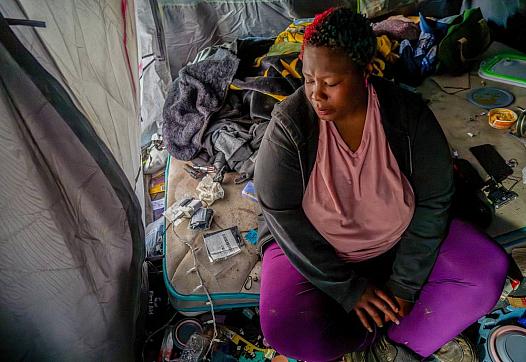How much does Sacramento County spend jailing homeless people? Here’s what we know
The story was originally published by the The Sacramento Bee with support from our 2024 Data Fellowship.
About one-third of bookings in the Sacramento County Main Jail involve homeless people.
The county’s Department of Health Services released data showing that, over the year between October 2023 and the end of September 2024, 10,548 bookings involved someone who was homeless. The data also show that on average, 838 homeless individuals were held in the jail each month.
If each homeless person spent only 24 hours in jail for each arrest, it would cost the county $2,106,752 before any medical expenses.
Of those 838 people each month, an average of 126 people — a significant minority — have been diagnosed with at least one of the following serious mental illnesses: schizophrenia spectrum and other psychotic disorders; borderline personality disorder; PTSD; major depressive disorder; or bipolar and related disorders.
The Sacramento County Main Jail and the Rio Cosumnes Correctional Center south of Elk Grove are the subject of a federal consent decree related to inadequate medical and mental health care. The county has previously said that for many people, particularly those with mental illnesses, jail is not the most appropriate — or cost-efficient — setting.
People with serious mental illnesses are also overrepresented in the small number of “high utilizers” of the jail. A 2022 report by an outside consultant, Kevin O’Connell, defined high utilizers as people with four or more separate stints in jail within the course of a year. In 2020, there were 663 of them.
The 663 people who ended up in jail four or more times in a year were, O’Connell wrote, “often low-level offenders returning with unaddressed needs such as substance abuse, alcoholism, and mental health issues. These chronic low-level offenders create stress and liability for a jail operation that can do little to address the underlying issues.” Nearly 50% of them, he said, had a serious mental illness; a majority were homeless.
Over the year, he found they spent a total of 110 days in jail on average.
In 2018, the average daily cost of spending one day in jail was $126.06, before any medical expenses. With that figure, high users cost, on average, $13,867. If we assumed that a quarter of the high users were homeless and that they each spent 110 days in custody, that would have come out to $2,298,389, using the 2018 average daily cost. The daily cost has gone up considerably since then, to $199.73. With the current number, the annual cost for about 166 people to each spend 110 days in jail would be $3,641,577.
These are calculations based on averages — in other words, they are rough estimates. But they could help Sacramento County residents to understand the amount of money being poured into this part of the homelessness response.
What did we learn from new jail data?
The newly released data from the Department of Health Services show more than 700 individuals each month were homeless. Monthly booking numbers published by the Board of State and Community Corrections confirms that at least 30% of bookings each month during that one-year period were of homeless people.
Though medical staff collect information on homelessness, the Sacramento County Sheriff’s Office does not monitor this among the jail population in any systematic way.
Sheriff’s Office attorney Diane Vasquez wrote, regarding a Public Records Act request from The Sacramento Bee, that the law enforcement agency “does not track an arrestee’s housing status.”
Housing the homeless in jail
Sacramento County appropriates more than $55 million a year to the Department of Homeless Services and Housing — a sum that does not include the money spent housing homeless people in jail. Though the data released by the county do not show how long homeless people typically spend behind bars in Sacramento County, other records shed some light on the number of people stuck in jail with no financial resources
The Sacramento County Sheriff’s Office does not provide basic necessities such as soap and toothpaste to jailed people automatically; however, if people in the jail cannot afford such items at the commissary, the sheriff’s office will provide an “indigent kit” weekly on credit. The office released records on the indigent kits given out over four months of last year, starting May 1, 2024.
Over those four months, 1,899 kits were delivered to people in the jail. The records show the jail counted nearly $63,000 in inmate debt. The kits are typically handed out no more than once a week. The records do not indicate whether the individuals were receiving the kits in consecutive weeks, but they do show that 112 individuals had accrued more than six months’ worth of debt buying basic necessities. Of those, 22 of them appeared to have been locked up for more than a year.
The county spends over $36,000 incarcerating a person for six months, before any medical expenses.


